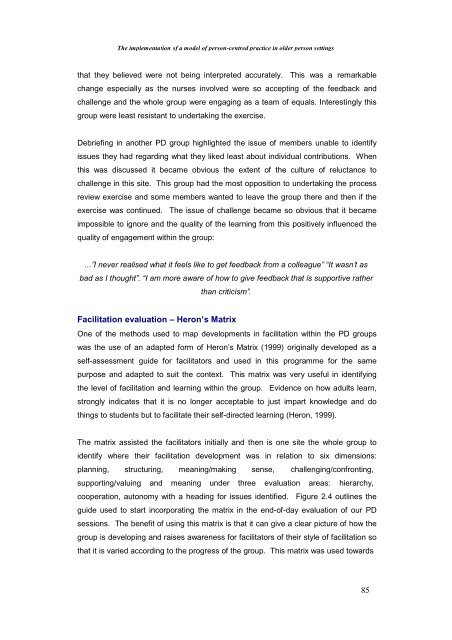The Implementation of a Model of Person-Centred Practice In Older ...
The Implementation of a Model of Person-Centred Practice In Older ...
The Implementation of a Model of Person-Centred Practice In Older ...
Create successful ePaper yourself
Turn your PDF publications into a flip-book with our unique Google optimized e-Paper software.
<strong>The</strong> implementation <strong>of</strong> a model <strong>of</strong> person-centred practice in older person settings<br />
that they believed were not being interpreted accurately. This was a remarkable<br />
change especially as the nurses involved were so accepting <strong>of</strong> the feedback and<br />
challenge and the whole group were engaging as a team <strong>of</strong> equals. <strong>In</strong>terestingly this<br />
group were least resistant to undertaking the exercise.<br />
Debriefing in another PD group highlighted the issue <strong>of</strong> members unable to identify<br />
issues they had regarding what they liked least about individual contributions. When<br />
this was discussed it became obvious the extent <strong>of</strong> the culture <strong>of</strong> reluctance to<br />
challenge in this site. This group had the most opposition to undertaking the process<br />
review exercise and some members wanted to leave the group there and then if the<br />
exercise was continued. <strong>The</strong> issue <strong>of</strong> challenge became so obvious that it became<br />
impossible to ignore and the quality <strong>of</strong> the learning from this positively influenced the<br />
quality <strong>of</strong> engagement within the group:<br />
...”I never realised what it feels like to get feedback from a colleague” “It wasn’t as<br />
bad as I thought”. “I am more aware <strong>of</strong> how to give feedback that is supportive rather<br />
than criticism”.<br />
Facilitation evaluation – Heron’s Matrix<br />
One <strong>of</strong> the methods used to map developments in facilitation within the PD groups<br />
was the use <strong>of</strong> an adapted form <strong>of</strong> Heron’s Matrix (1999) originally developed as a<br />
self-assessment guide for facilitators and used in this programme for the same<br />
purpose and adapted to suit the context. This matrix was very useful in identifying<br />
the level <strong>of</strong> facilitation and learning within the group. Evidence on how adults learn,<br />
strongly indicates that it is no longer acceptable to just impart knowledge and do<br />
things to students but to facilitate their self-directed learning (Heron, 1999).<br />
<strong>The</strong> matrix assisted the facilitators initially and then is one site the whole group to<br />
identify where their facilitation development was in relation to six dimensions:<br />
planning, structuring, meaning/making sense, challenging/confronting,<br />
supporting/valuing and meaning under three evaluation areas: hierarchy,<br />
cooperation, autonomy with a heading for issues identified. Figure 2.4 outlines the<br />
guide used to start incorporating the matrix in the end-<strong>of</strong>-day evaluation <strong>of</strong> our PD<br />
sessions. <strong>The</strong> benefit <strong>of</strong> using this matrix is that it can give a clear picture <strong>of</strong> how the<br />
group is developing and raises awareness for facilitators <strong>of</strong> their style <strong>of</strong> facilitation so<br />
that it is varied according to the progress <strong>of</strong> the group. This matrix was used towards<br />
85
















